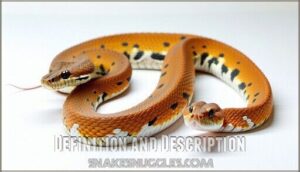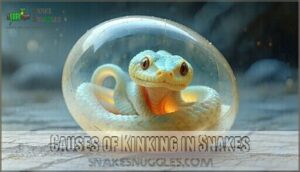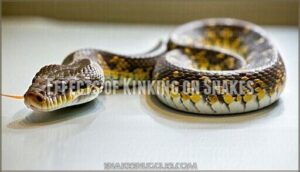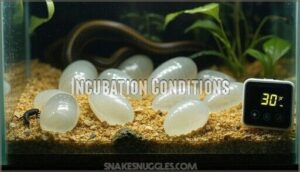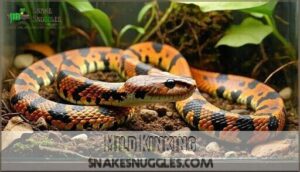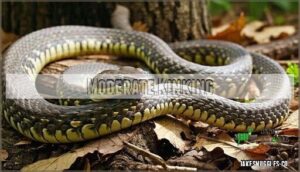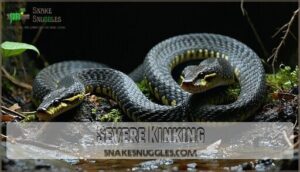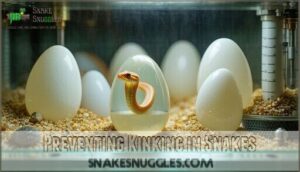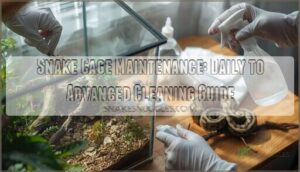This site is supported by our readers. We may earn a commission, at no cost to you, if you purchase through links.
 Kinking in snakes happens when their spine develops abnormal curves or bends, making them look like a twisted garden hose.
Kinking in snakes happens when their spine develops abnormal curves or bends, making them look like a twisted garden hose.
You’ll notice these permanent deformities as sharp angles or S-curves in their body instead of smooth, flowing movement.
Genetic issues cause most cases, but poor incubation conditions, nutritional deficiencies, or temperature problems during development can also trigger kinking.
It’s basically nature’s version of a manufacturing defect.
Mild cases might barely affect your snake’s quality of life, while severe kinking can impact movement, feeding, and overall health.
The good news? Understanding the causes helps prevent this condition in future generations and manage affected snakes properly.
Table Of Contents
- Key Takeaways
- What is Snake Kinking
- Managing a Kinked Snake
- Preventing Kinking in Snakes
- Kinking Behavior in Snakes
- Living With a Kinked Snake
- Frequently Asked Questions (FAQs)
- What causes kinks in snakes?
- What makes snakes look rippled up?
- What is kinking in a snake?
- Why do snakes kink?
- What is a kinked drain snake?
- What does it mean if a snake has a kinked spine?
- Why would a snake look kinked?
- What does kinking mean in snakes?
- Can a snake live with a kink?
- What are tail kinks in snakes?
- Conclusion
Key Takeaways
- Kinking creates permanent spine deformities – You’ll see unnatural bends or twists in your snake’s backbone that can range from mild tail curves to severe zigzag patterns affecting their entire body.
- Genetics are the main culprit – Certain morphs, like Spider Ball Pythons and Caramel Albinos, have up to 80% kinking rates, so you need to research bloodlines and avoid inbreeding when selecting snakes.
- Incubation conditions matter critically – You must maintain precise temperatures (80-90°F) and humidity (80-100%) during egg development, as even small fluctuations can increase kinking rates by 40%.
- Many kinked snakes can live normal lives – You can successfully manage mild to moderate cases with proper care, though severe kinking affecting digestion or mobility may require difficult euthanasia decisions.
What is Snake Kinking
You’ve likely heard of scoliosis in humans, but snakes can develop similar spinal deformities called kinking.
This condition creates unnatural bends or twists in a snake’s spine that can range from barely noticeable curves to severe zig-zag patterns.
Definition and Description
Snake kinking resembles a crumpled garden hose—your pet’s spine bends at unnatural angles instead of flowing smoothly. This spinal abnormality creates visible deformities ranging from subtle curves to dramatic zigzag patterns.
Kink severity affects your snake’s quality of life differently:
- Mild bends – barely noticeable tail curves
- Moderate twists – visible spine irregularities
- Severe deformities – dramatic S-shaped distortions
- Multiple kinks – several bends throughout the body
- Spinal compression – compressed vertebrae causing shortened appearance
Identifying kinking requires examining your snake’s physical appearance for these congenital defects.
Causes of Kinking in Snakes
Multiple factors contribute to snake kinking, creating a complex web of causes. Genetic Predisposition plays a major role – certain morphs like Spider Ball Pythons carry inherited traits that increase kinking risks.
Inbreeding Risks compound this problem by reducing genetic diversity.
- Incubation Temperature fluctuations during development trigger spinal malformations
- Humidity Levels below 50% quadruple abnormality rates in developing embryos
- Maternal Stress and nutritional deficiencies affect offspring development
- Environmental factors like physical trauma to eggs increase deformity likelihood
Effects of Kinking on Snakes
When snake spinal deformity strikes, your pet faces a cascade of health challenges.
Mobility impairment turns simple slithering into a struggle, while digestive issues can block food passage through kinked sections.
Reproductive problems and potential nerve damage may follow, ultimately leading to reduced lifespan if severe kinking behavior isn’t properly managed.
Regular check-ups can help monitor signs of illness.
Genetic Factors
Genetic factors play a major role in snake kinking, with certain inherited traits making some morphs more susceptible than others.
- Spider ball pythons show up to 80% kinking rates due to specific genetic mutations
- Caramel morphs frequently develop spinal deformities from birth-linked gene defects
- Inbreeding risks amplify these unidentified abnormalities in captive breeding programs
Environmental Factors
Environmental factors during incubation dramatically affect snake kinking development.
Temperature control between 80-90°F and humidity levels at 80-100% are critical.
Maternal stress from poor conditions increases kinking by 15%.
Substrate impact and ventilation systems also matter.
| Factor | Optimal Range | Risk if Incorrect |
|---|---|---|
| Incubation Temperature | 80-90°F | Up to 50% kinking rate |
| Humidity Levels | 80-100% | 20% increase in malformations |
| Maternal Stress | Minimal disturbance | 15% higher deformity rates |
| Egg Handling | Stable placement | 12% increased kinking |
Incubation conditions require precision—think perfect recipe execution, not guesswork!
Nutritional Factors
Proper snake nutrition plays a vital role in preventing kinking.
Dietary deficiencies in calcium, vitamin D3, and protein can weaken developing bones and increase deformity risks.
Mineral deficiency disrupts bone formation, while inadequate prey size or irregular feeding creates metabolic disorders.
Smart supplementation needs and consistent feeding schedules support healthy spinal development—it’s like building a strong foundation for your snake’s backbone.
Incubation Conditions
Precision during snake incubation determines your hatchlings’ spinal health.
Perfect incubation conditions create healthy spines – one degree off can change everything.
Temperature fluctuations above 32°C increase kinking by 40%, while maintaining 28-30°C keeps malformations under 5%.
- Temperature Stability: Avoid fluctuations that cause vertebral defects
- Humidity Levels: Maintain 60-80% to prevent spine formation issues
- Substrate Choice: Use vermiculite or perlite for moisture balance
- Ventilation Impact: Proper airflow prevents overheating and contamination
Managing a Kinked Snake
If you discover your snake has kinking, don’t panic—many cases can be managed successfully with the right approach.
The key is evaluating the severity and adjusting your care routine to keep your scaly friend comfortable and healthy, which is crucial for managing the condition effectively with the right approach.
Mild Kinking
Mild kinking presents minimal snake health issues, typically appearing as slight bends in the snake spine.
You’ll find Limited Impact on your pet’s Quality of Life, especially with tail-end deformities.
Early Detection helps track changes, though Monitoring Signs isn’t urgent.
Most snakes develop Adaptive Strategies naturally, moving gracefully despite minor snake skeletal issues.
| Severity Level | Location | Impact on Function |
|---|---|---|
| Very Mild | Tail tip | No movement restriction |
| Mild | Mid-tail | Slight flexibility reduction |
| Light Moderate | Lower spine | Minor hunting adjustments |
| Borderline | Upper tail | Occasional movement compensation |
Moderate Kinking
Moving beyond mild cases that barely affect daily life, moderate kinking presents more serious challenges for your snake’s well-being.
You’ll notice digestive impairment as sharp spinal bends create roadblocks in your snake’s digestive tract, like trying to squeeze food through a kinked garden hose. Mobility limitations become apparent during feeding and normal movement.
Here’s what moderate kinking affects:
- Digestive function – Food may get stuck at bend points, causing malnutrition
- Movement patterns – Your snake can’t coil properly or navigate tight spaces
- Overall comfort – Awkward positioning during rest and activity
Quality of life decreases noticeably compared to mild kinking cases. Veterinary assessment becomes important to determine if supportive care can help manage these snake deformities effectively. The snake spine abnormalities require careful monitoring to prevent complications.
Severe Kinking
Severe kinking transforms your snake’s spine into twisted pretzel shapes, causing impaired mobility and serious digestive complications.
These snake vertebrae problems can lead to neurological damage, making movement painful or impossible.
Severe kinking often triggers difficult euthanasia decisions due to ethical implications.
When snake congenital defects this extreme occur, snake genetics and snake deformities create suffering that’s hard to watch.
Such issues can sometimes be traced back to poor enclosure ventilation.
Euthanasia Considerations
Sometimes tough decisions arrive with severe snake kinking cases. When quality of life plummets and snake pain becomes chronic, ethical dilemmas emerge like unwelcome houseguests.
Severity assessment involves three key factors:
- The snake’s suffering level
- Its overall quality of life
- Available humane methods
Breeder responsibility includes consulting reptile-experienced vets who understand snake severe kinking nuances. Snake euthanasia management requires professional guidance – you’re not traversing this alone.
Legal implications vary by location, but prioritizing your snake’s welfare remains paramount.
Preventing Kinking in Snakes
You can prevent kinking in snakes through careful breeding choices and precise incubation management.
Think of it like baking a cake – get the recipe wrong, and you’ll end up with something that doesn’t look quite right, which can be considered a complete concept in understanding the importance of precise management.
Selective Breeding
When you’re serious about snake breeding, smart selective breeding becomes your best defense against kinking. Genetic diversity is your secret weapon—avoid pairing relatives or snake morphs known for trait heritability problems. Morph selection matters big time.
Super Cinnamon and Caramel Albino ball pythons? They’re kinking magnets. Kinking, a spinal deformation, is frequently observed in Caramel Albino morphs.
Lineage tracking isn’t just paperwork—it’s preventing heartbreak. Keep detailed records of which snakes produced what. Kinking genetics can hide for generations before surprising you.
Genetic diversity
Breed standards
Ethical implications
The ethical implications are real—snake genetic disorders mean suffering.
Proper Incubation Techniques
Proper incubation techniques create the foundation for healthy snake hatchlings. Your incubator becomes a nursery where precise conditions prevent developmental issues like kinking.
Consider these essential elements:
- Temperature Stability – Maintain species-specific ranges without fluctuations
- Humidity Levels – Monitor closely using reliable hygrometers
- Substrate Choice – Use vermiculite or perlite for ideal moisture retention
- Ventilation Needs – Guarantee adequate airflow without drying out snake eggs
Egg Turning isn’t necessary, but gentle monitoring helps catch problems early. Many keepers source a reliable egg incubator for this purpose.
Maintaining Optimal Temperature
You’ll want to nail down the snake incubation temperature to prevent snake kinking disasters. Think of temperature fluctuations as a roller coaster your developing snake doesn’t want to ride! Incubation thermometers are your best friends for monitoring your snake environment.
Quality heat sources maintain steady temperature gradients, while backup systems protect against power outages. Snake temperature control management isn’t just about hitting the right number—it’s about consistency.
To guarantee accuracy, consider using a calibrated digital thermometer.
- Monitor snake temperature gradient with calibrated incubation thermometers daily
- Install reliable heat source systems with battery backup for power outages
- Avoid seasonal variation effects by maintaining stable conditions year-round
Providing Humidity Control
While temperature matters, humidity control prevents snake kinking just as effectively.
Ball python eggs need 90-100% humidity, while corn snakes require 80-90%.
Use humidity monitoring devices and misting techniques to maintain consistent levels.
Poor hydration methods cause shedding issues that stress developing embryos.
Smart enclosure design with proper ventilation prevents stagnant air while keeping moisture ideal for healthy snake development.
Accurate readings require quality humidity monitoring options.
Kinking Behavior in Snakes
When you see a snake twisting its body into unusual positions, it’s not having a spine problem – it’s showing off a clever survival trick.
This kinking behavior is actually a smart defense strategy that many snake species use to confuse predators and blend into their surroundings.
Why Do Snakes Kink
While kinking might look like snake back problems, it’s actually a clever adaptive advantage that helps snakes survive in the wild.
Snakes use this defensive posture as a camouflage strategy, making themselves look like twisted branches or dead sticks to fool predators.
Here’s why snakes develop this spinal deformity behavior:
- Thermoregulation – Kinking helps with body thermoregulation by changing surface area exposed to heat or cold
- Traction improvement – Creates better grip on smooth surfaces for enhanced snake movement
- Predator confusion – The zigzag pattern breaks up their silhouette, confusing potential threats
- Hunting advantage – Some species use kinking to position themselves better for ambush attacks
This snake health adaptation shows nature’s creativity in solving survival challenges.
Benefits of Kinking Behavior
Snakes master body manipulation through kinking, turning their spines into Swiss Army knives.
This adaptive trait delivers serious advantages: camouflage adaptation helps them vanish among twisted branches, while defensive posture confuses predators.
Traction improvement lets them grip slippery surfaces better, and heat regulation keeps their body temperature just right.
It’s nature’s ultimate evolutionary advantage for survival.
Kinking in Different Species
Different species show varying kinking patterns that’ll surprise you.
While ball pythons display higher morph prevalence in captivity, wild kinking occurs naturally in some populations.
- Ball pythons – Spider and super cinnamon morphs show increased rates
- Corn snakes – Albino lines exhibit mild spinal bends
- Boa constrictors – Recessive morphs display higher deformity risks
- Geographic variation affects adaptive kinking across snake ranges
Common Kinking Snake Breeds
While some species naturally kink for camouflage, certain snake breeds are genetically prone to spinal deformities.
Ball Python Kinks plague specific morphs like Caramel Albinos and Super Cinnamons. Corn Snake Kinks occur less frequently but still affect some bloodlines. Kingsnake Issues typically involve minor tail kinks that don’t impact quality of life.
Owners should be aware that these snakes may require specialized feeding or assisted shedding.
| Breed | Kinking Prevalence | Morph Predisposition |
|---|---|---|
| Ball Pythons | High in certain morphs | Caramel, Super Cinnamon |
| Corn Snakes | Low to moderate | Various morphs |
| Kingsnakes | Occasional | Limited morph association |
Understanding these common kinking breeds helps you make informed decisions when selecting your future companion.
Living With a Kinked Snake
If you’re caring for a kinked snake, don’t worry – many of these reptiles can live happy, fulfilling lives with the right approach.
The key is understanding your snake’s specific needs and adjusting their environment to help them thrive despite their spinal condition.
Managing a Kinked Snake’s Health
Managing your kinked snake’s health requires a thoughtful approach.
Dietary adjustments with nutrient-rich foods support overall wellness, while pain management through gentle handling minimizes discomfort.
Veterinary imaging helps assess severity and guide kinking treatment decisions.
Supportive therapies like warm soaks can ease mobility issues.
Regular vet checkups confirm you’re managing health effectively, catching problems early and maintaining your snake’s quality of life through proper care.
Providing a Suitable Environment
With proper environmental factors, your kinked snake can thrive like a champ. Enclosure Size should provide adequate room without overwhelming them—think cozy apartment, not football stadium.
Create Temperature Gradients from 75-85°F so they can thermoregulate naturally. Hiding Spots on both warm and cool sides reduce stress substantially.
Choose appropriate Substrate Choice like cypress mulch for humidity retention. Add Enrichment Activities through branches and climbing opportunities.
A key element is providing shelter with logs and rock piles. This suitable environment supports snake husbandry basics while accommodating their unique needs.
- Picture a snake choosing between a sunny spot and shady corner like picking the perfect seat
- Imagine hiding spots as personal caves where they feel completely secure
- Envision climbing branches creating natural highways through their world
Handling and Care of Kinked Snakes
Caring for kinked snakes requires gentle handling and extra attention to their unique needs.
You’ll need to support their body during handling, avoiding pressure on kinked areas.
Enclosure enrichment with soft surfaces helps prevent injury.
Feeding challenges may arise, so offer appropriately sized prey.
Monitoring health closely is vital – watch for mobility issues or digestive problems.
Veterinary support becomes essential for ongoing snake care.
Think of snake husbandry as creating a safe haven where your kinked companion can thrive despite their condition.
safe objects
room to move
Frequently Asked Questions (FAQs)
What causes kinks in snakes?
Studies show certain ball python morphs have kinking rates up to 15% higher than normal varieties. You’ll find genetics, improper incubation temperatures, and inbreeding cause most spine deformities in snakes.
What makes snakes look rippled up?
You’ll see snakes looking rippled when they’re kinked – basically their spine bends at weird angles, creating that wavy, zigzag appearance instead of smooth curves.
What is kinking in a snake?
Like a garden hose with stubborn bends, kinking creates unnatural twists in your snake’s spine.
You’ll see anything from slight curves to severe zig-zag patterns that can mess with movement and digestion.
Why do snakes kink?
Snakes kink for two main reasons: as a defensive behavior to mimic sticks or dead snakes, and due to spinal deformities from genetic factors or poor incubation conditions during development.
What is a kinked drain snake?
When your drain snake becomes twisted like a stubborn pretzel, you’ve got a kinked drain snake.
This happens when you’re pushing too hard or the cable gets tangled, making it useless for clearing clogs.
What does it mean if a snake has a kinked spine?
If you notice your snake’s spine has an unnatural bend or twist, that’s kinking – a developmental condition causing zig-zag curves that can affect movement and digestion depending on severity.
Why would a snake look kinked?
You’d see a kinked snake if it’s using defensive behavior (mimicking dead branches) or has spinal deformities from genetics, poor incubation temperatures, or developmental issues affecting its backbone.
What does kinking mean in snakes?
When you spot a snake with unnatural bends or twists in its spine, that’s kinking.
It’s like scoliosis but for snakes, caused by genetics, poor incubation conditions, or nutritional issues during development.
Can a snake live with a kink?
A snake can definitely live with minor kinking, especially if it’s at the tail end. However, severe spinal kinks affecting digestion or mobility may require euthanasia to prevent suffering.
What are tail kinks in snakes?
Tail kinks aren’t just dramatic spine twists – they’re gentle bends at your snake’s rear end that barely impact their quality of life, unlike severe body kinking.
Conclusion
Understanding what’s kinking in snakes isn’t rocket science, but it’s absolutely essential for every snake owner and breeder.
You’ve now got the complete playbook for recognizing, preventing, and managing this spinal condition. Remember, genetics play the starring role, but environmental factors during incubation can steal the show.
Whether you’re dealing with mild curves or severe deformities, proper care makes all the difference. Keep those incubation temperatures steady, choose breeding pairs wisely, and you’ll dramatically reduce kinking risks in future generations.
- https://www.nwreptiles.com/ball-python-genetic-behaviors-and-morph-breeding-oddities/
- https://www.youtube.com/watch?v=oCsrfvKvm_s
- https://community.morphmarket.com/t/breeding-snakes-with-a-deformity/29706
- https://www.reddit.com/r/snakes/comments/6putvm/king_snakes_vs_ball_pythons/
- https://ourreptileforum.com/community/threads/snake-back-and-tail-kinks.22933/

